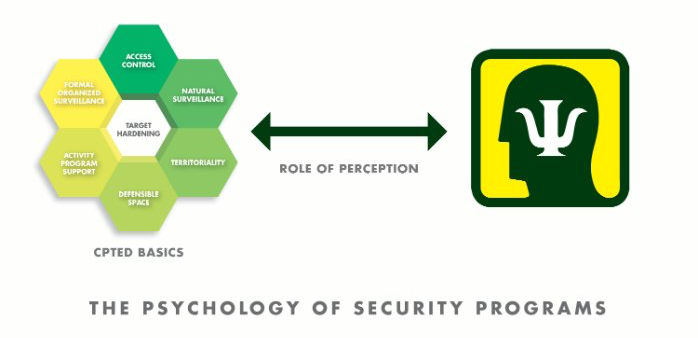WHEN THERE IS A FRACTURE BETWEEN PERCEPTION & REALITY SECURITY SUFFERS
Security programs are much more effective when they are perceived as being effective and comprehensive. Conversely, when otherwise well designed security programs are perceived as being weak, weakness is the likely result. Most security programs are only as good as their weakest link.
Consider two shopping malls.
- Mall number one has trash blowing about the parking lot, a few lights are burnt out, the landscaping in not well kept, there is graffiti on the exterior walls of building and there is cracked window here and there.
- Mall number two is pristine, well lit with LED luminaries, the landscaping is well kept and shrubbery is kept below three feet and there are no cracked windows.
Which of these two malls has a higher rate of crime. Whether we are talking about malls or hospitals, schools or high-rise buildings good housekeeping, lighting and an obvious security presence, enhanced by effective CPTED design are all vitally important. This analogy is also applicable to schools, hospitals, apartment complexes, supply chain operations and manufacturing sites.
All too often The Security Solution Hierarchy gets turned upside-down (see below):http://www.smsiinc.com/education-center/security-solution-hierarchy/
The SMSI Security Solution Hierarchy provides a logical construct, as well as a foundational basis, for developing and effective, and more importantly, relevant, security program. You will notice the we placed CPTED strategies at the second level. One could argue that CPTED should be at the first level, or more importantly, at every level.
However, if we have locks on doors, but those doors are continually propped open because man employee wanted to take a smoke break, how is the perception of the security program affected? If security officers are socializing while on the job, or found sleeping on the job, how is the overall security program impacted? If 25% of the employees have grand master keys, how is the deterrent value of the locking program affected. If access control pass-cards are issued on the basis of convenience, as opposed to need, the access mamangment program is diminished. If the landscaping and general housekeeping are substandard, what message does that send to would-be perpetrators? Security methodologies, by definition, are intended to cause some inconvenience. That is why we do not leave all the doors open.
Security programs must be dynamic and flexible enough to adjust to any and all changes in the threat environment. One size does not fit all. The best security programs are flexible, adaptive and information driven. It is imperative that the symptoms of weakness are recognized early in the process. Because of products, such as Report Exec. (http://www.reportexec.com/ ) this task has been simplified. In the past Daily Activity Logs and Incident Reports languished in file drawers and loose-leaf binders. Today, sophisticated trend analysis is just a few clicks away. These systems can quickly provide the rationale for effective corrective actions as well as support internal investigations. Report Exec will tell you what is working, and more importantly, what is not working.
Finally, if you support the notion that Perception is a vital component of any credible security program, than what better means to accomplish these goal than Employee Involve & Participation thought the development of a system wide Security Awareness Program (SAP). SAPs are one of the most cost-effective strategies for creating the perception of a robust and effective security programs. I often ask my clients the rhetorical question: What do think is more effective; 200 cameras or 2000 sets of eyes and ears and a brain? Involved employees will make any security program better with little, or no, budgetary impact.
Clearly the CPTED strategy, of Natural Surveillance, Natural Access Control and Natural Territoriality is significantly enhanced by engaged employees. The CPTED strategies and SAP are applicable to the mitigation of both internal and external threats. The bottom-line: A good security program is weakened if the general perception is the security program is perceived as being ineffective. Conversely, when an otherwise mediocre security program is perceived as being strong and effective, it bodes well for effectiveness.
For these reasons, and others, as part of our security assessment process, we have developed a Likert style questionnaire. This questionnaire is intended to define the perceptions of employees as to how they feel about the security program where they work. As part of the process, we guarantee each employee anonymity when they volunteer to participate in this process. When perceptions are antithetical to an effective security program, the challenge becomes to do whatever is required to change negative perceptions to positive perceptions.
Is there a disconnect between Reality and Perception for your security program? If so, is it positive or negation. The multiplier effect of engaged employees has tremendous cost effective benefits.
Your views, regarding the role of perception as a component, and a significant factor in the development of any security program, are welcome. The LinkedIn Community provides a vehicle for us to learn from the experiences of one another.
William H. Nesbitt CPP, (bill@smsiinc.com) Phone: 805-499-3800
President – Security Management Services International, Inc.

